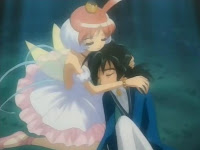When choosing 2002, I did so without much thought into what had actually aired. Back in these days I was pretty much a youngin' who hadn't yet discovered anime outside of the things that had made its way to North American television. 2002 was a year that anime really started to thrive in the West with Spirited Away even winning the Oscar for Best Animated Film, but as for Japan? I wasn't really sure how it was shaping out there, but what I ended up discovering was that it was a year filled with some of the most popular series out there that new and old anime fans still turn to watch today.
Azumanga Daioh is one of those series that brought laughter to all and created an eccentric cast of characters that really brought to life the 4-koma manga format. Due this series' success, it isn't too much of a stretch to say it no doubt inspired many other series of its kind that came afterwards. (Shows such as Hidamari Sketch and the recent Yuyushiki come to mind. - Ed.) In contrast to other 4-koma adaptations, when this one was airing from April to September, it would be broadcasted every day of the week in short five minute segments, only to be compiled into one episode for the weekend on the format we are more accustomed to. Nonetheless, the daily high school lives of Chiyo and her friends skyrocketed in sales and proved that a cat for a dad and one hell of a creepy teacher was enough to entertain thousands!
As the school girl comedy was warming the hearts of thousands, so was the revamp of the "Real Robot" genre with Mobile Suit Gundam Seed. It began its run late in October, but its story, one that was more or less much like other Gundam series, convinced audiences once more why they should keep an eye on the genre. However, it wasn't just Gundam Seed that did the trick; this is the year that Full Metal Panic! also graced the screens of Japan. This is a mecha series that really knew how to balance its school life elements with its action. It brought on a new generation of fans who would talk more about the characters than any of the action.
This change from the usual focus is also seen in another anime of 2002 with .hack//Sign. The series is the first of its kind with the characters being trapped in a video game, a concept not too far from more modern shows (Sword Art Online, Ixion Saga DT). Despite that, our hero Tsukasa doesn't rise to the bar and instead becomes someone who avoids the company of others, cynical towards everyone around them for a good deal of the time. It has a slow pacing and doesn't even have much action in it at all, on account of that. and although many do applaud it for its creativity, others criticize it for being a difficult watch. The debate towards its worth is something people still question today.
Another rather misunderstood series of 2002 is Princess Tutu. This was another series that had an unusual airing format where, although it is now considered to be only one complete series, it was originally aired as two separate seasons--its second half would air in 12 minute chunks, which was a decision made to allow it to be able to fit the timeslot the network gave it. Tutu is a series that takes a unique approach to the magical-girl genre, along with a fondness to ballet. It is a story about a duck who wants to become human. Although many were uninterested because at a glance it may seem unappealing, it continues to be an underrated gem that tells a thrilling tale that encompasses several classical stage stories.
Last, but certainly not least, one of the most notable titles of this year was Naruto, the instant Shonen Jump hit about a boy who really wants to be the best ninja out there. Just recently I had finished this series myself, and the beginning actually does manage to be surprisingly good. Not to mention, the beginning of the series instead chose to just deliver a direct adaptation, instead of a filler filled mess it ended up being remembered for. The series manages to shine in creating both villains and heroes worth cheering for, along with an interesting world for them to live in. The anime aired near the end of 2002 in October and went on to create one of the biggest anime followings out there that stretches across the globe. The first few episodes of this series also had probably the most memorable theme from the whole franchise with Akeboshi's debut single "Wind".
To conclude, 2002 was a year that started more than a few of the most popular anime fandoms of today. Japan was testing the waters with unlikely heroes and bringing back some favourites. It was also the year where one of the most popular studios finally made their big break into the business. On account of series like Gundam Seed and Azumanga Daioh, anime in Japan finally made some really big sales for the new millennium, which helped to prove that from here on out, anime would only grow to become bigger and bigger!
Next time: Four decades down, one decade to go! Here comes 2003!







2002 had more high profile series than I realized. Good article. But I have a minor gripe. Where is Haibane Renmei?; it also aired in 2002.
ReplyDeletehaibane renmei - Hanada Shōnen Shi - Magical Shopping Arcade Abenobashi
ReplyDelete